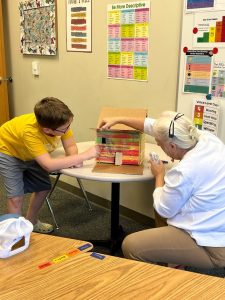Building Cabins, Building Minds: The Power of Hands-On Learning for Neurodivergent Learners
Last week, Ms. Hershelman’s class at our school brought the novel Trouble River to life by constructing a cabin, reflecting the story’s setting and themes. This immersive experience went beyond just reading about the story—it allowed students to physically engage with the material in a way that deepened their understanding and connection to it. This creative approach to education is a fantastic example of how hands-on learning can enhance engagement, especially for neurodivergent learners.
Why Hands-On Learning Matters for Neurodivergent Students
For students with learning differences hands-on learning isn’t just an option—it’s often essential. Neurodivergent learners, including those with ADHD, dyslexia, and other differences, tend to thrive in environments where they can engage all their senses. Building a cabin isn’t just a fun activity; it incorporates visual, tactile, and kinesthetic learning, which helps reinforce the content in a way that traditional reading or lecture-based learning may not.
Research shows that multisensory learning techniques can improve information retention and comprehension, particularly for students with dyslexia and other processing disorders. A study from the Journal of Learning Disabilities indicates that students who engage in hands-on, multisensory learning activities show higher levels of engagement and retention than those taught through traditional methods. In Ms. Hershelman’s class, building the cabin transforms the abstract world of Trouble River into something tangible and memorable.
Bringing Hands-On Learning Home
While these techniques are used in classrooms, there are also ways to bring hands-on learning into your home to support your neurodivergent child’s education. Here are a few ideas for parents to try:
1. Create Sensory Bins
Sensory bins are a great way to engage tactile learners. You can fill them with materials that correspond to your child’s current lessons—such as sand or water for geography lessons or small figures to represent characters from a book they’re reading. This type of multisensory play helps solidify abstract concepts.
2. Dramatize Lessons
Just like Ms. Hershelman’s class built a cabin to bring their novel to life, you can use simple props at home to reenact scenes from a story or history lesson. Acting out a concept engages multiple senses and can help children better remember what they’ve learned.
3. Incorporate Art and Building Projects
For students who struggle with reading comprehension, drawing or building scenes from the text can be a powerful way to connect with the material. Encourage your child to build a model of a setting, create a comic strip of important scenes, or design a “book in a box” where they place objects that represent key parts of the story inside a small box or diorama.
4. Use Movement for Math and Science
Math manipulatives like blocks or beads are excellent for making abstract concepts concrete. Even outside the classroom, movement-based activities like jumping rope while practicing multiplication or using play dough to model science concepts can be incredibly beneficial.
For more ideas on how to apply these strategies at home, check out these resources:
- Understood.org offers a wide range of resources for parents of children with learning and attention issues. Their articles on multisensory learning and specific strategies for neurodivergent students are particularly helpful.
- The Child Mind Institute provides comprehensive advice on how parents can help their neurodivergent children succeed both in and out of the classroom. They offer hands-on learning tips and strategies for home.
- ADDitude Magazine focuses on ADHD, learning disabilities, and related issues. Their website has practical advice and techniques for multisensory learning and engaging neurodivergent students at home.
At our school, we understand the importance of making learning accessible and engaging for all students, particularly those who learn differently. Ms. Hershelman’s class serves as a perfect reminder that when we meet students where they are, providing them with opportunities to interact with their education in meaningful ways, we open doors to deeper understanding and success.






Sorry, the comment form is closed at this time.